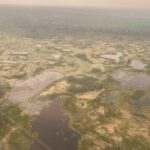Task 241
Interactive processes between cloud-precipitation, land-surface, radiation, and aerosol processes
Principal Investigator(s):
T. Matsui
Sponsor(s):
W-K. Tao
Last Updated:
October 26, 2012 15:26:08
Description of Problem
Aerosols, cloud, and precipitation processes play major roles in describing earth’s energy and water budget and cycle. Thus, understanding of these processes and interactions via in-situ observations, satellite remote sensing, and state-of-art numerical modeling is essential for atmospheric scientists. However, links between satellite observations and modeling have been always untied, because assumptions in geophysical parameters are usually different between them. Thus, a new tool must be developed to overcome such issue, and facilitate modeling development using satellite observations.
Scientific Objectives and Approach
Goddard Satellite Data Simulator Unit (G-SDSU) is the comprehensive satellite simulator that can reproduce L1 signals of different instruments of NASA’s satellites from high-resolution aerosol- cloud-precipitation model simulations, including Goddard Cumulus Ensemble (GCE) model, NASA-Unified Weather Research and Forecasting (NUWRF) model, and Goddard Multi-Scale Modeling Framework (G-MMF). In this way, the performance of these modeling systems can be evaluated against the satellite L1 signals. This new evaluation is superior to the traditional evaluation using satellite L2 data, because satellite data and model has identical physical assumptions. The detailed and comprehensive evaluation guides us to a better direction in model improvements. Eventually, the realistic model simulations and simulated satellite signals can also support satellite missions by serving as satellite algorithm testbed.
Accomplishments
Dr. Matsui accomplished several tasks in this year relating to the NUWRF. First, we finally finished the first fully coupled version of the NUWRF, which features
NASA-developed physics modules: a) Goddard one-moment bulk microphysics 2010, b) Goddard shortwave/longwave broadband radiation, c) Goddard Chemistry Aerosols Radiation Transport model (GOCART).
Externally coupled Modeling Systems to support observation-driven model framework: a) GSFC Land Information System (LIS) that includes various land-surface models, physical boundary conditions, data assimilation, and model evaluations, and b) the G-SDSU that allows the NUWRF simulation to be evaluated against satellite L1B observations.
Lateral and initial boundary conditions: In addition to the traditional NCEP global and regional models, the NU-WRF can be driven by the NASA GEOS-5 global forecasting simulations or the MERRA renalysis, and the global GOCART simulations for atmospheric aerosols.
Various physics modules, external modeling framework, and boundary conditions have been integrated and hardwired to simulate fully coupled aerosol-cloud-precipitation-land surface processes at the satellite-resolvable scales through the effort across NASA’s laboratories.
The fully coupled NUWRF simulation was conducted for the event of Mesoscale Convective System (MCS) over the West Africa associated with dust aerosols plume. This simulation is also coincided for African Monsoon Multidisciplinary Analyses (AMMA) experiments. The NUWRF simulations are conducted with two domains; horizontal grid spacings of mother and nested domains are 6km and 2km, respectively. Simulation runs with same physics configuration: Goddard semi-two-moment microphysics 2011, Goddard shortwave/longwave radiation, MYJ boundary layer scheme, and NOAH land-surface model, and GOCART scheme for aerosols. Boundary and initial conditions are derived from NCEP GFS forecasting models.
The NUWRF simulation was used to generate satellite observable radiance and backscattering through the G-SDSU with respect to the NASA A-Train satellites: Aqua MODIS infrared (IR) brightness temperature (Tb11μm), Aqua AMSR-E microwave brightness temperature at 89GHz(V) (Tb89GHZ). By comparing with the corresponding satellite L1B observations, it reveals the performance of the cloud-precipitation processes in the NUWRF simulations. The NUWRF simulation overestimates non-raining high clouds (~30% of domain), while it underestimates the non-raining low clouds (~30% of domain). In terms of convective-stratiform separation in raining cloud, the NUWRF simulation produced ~96% of stratiform rain, which is quite close to the observation (~98%). Thus, the G-SDSU makes the NUWRF as the “observation-driven” modeling framework.
Refereed Journal Publications
Shi, J. J., W.-K. Tao, T. Matsui, A. Hou, S. Lang, C. Peters-Lidard, G. Jackson, R. Cifelli, S. Rutledge, and W. Petersen (2010), Microphysical Properties of the January 20-22 2007 Snow Events over Canada: Comparison with in-situ and Satellite Observations. Journal of Applied Meteorology and Climatology. 49(11), 2246–2266.
Masunaga, H., Matsui, T., W.-K. Tao, A. Y. Hou, C. Kummerow, T. Nakajima, P. Bauer, W. Olson, M. Sekiguchi, and T. Y. Nakajima (2011), Satellite Data Simulator Unit: Multi-Sensor and Multi–Frequency Satellite Simulator package, Bulletin of American Meteorological Society, 91, 1625–1632. doi: 10.1175/2010BAMS2809.1.
Zeng, X., W.-K. Tao, T. Matsui, S. Xie, S. Lang, M. Zhang, D. Starr, and X. Li, (2011), Estimating the Ice Crystal Enhancement Factor in the Tropics. Journal of Atmospheric Science, 68, 1424–1434. doi: 10.1175/2011JAS3550.1
Tao, W.-K. and T. Matsui (2011), Cloud System Resolving Modeling and Aerosols, Encyclopedia of Atmospheric Sciences (accepted)
Matsui, T. and Mocko, D. M. (2011), Regional and seasonal variability of evaporation and transpiration, In Encyclopedia of Natural Resources, 1st Ed.; Wang, Y.Q., Ed.; Taylor & Francis Group: New York. (under review)
Ma, P.-L., K. Zhang, J.-J. Shi, T. Matsui; A. Arking, (2011): Direct Radiative Effect of Mineral Dust on the Development of African Easterly Wave in Late Summer, 2003-2007, Journal of Applied Meteorology and Climatology (under review)
Other Publications and Conferences
Matsui, T. (2011), (Invited) Ten-year climatology of summertime diurnal rainfall rate over the conterminous U.S. (Invited), Semester Seminar, Stony Brook University, Stony Brook, NY, 11, May, 2011.
Matsui, T., T. Iguchi, X. Li, and W.-K. Tao (2011), Current Status of the synthetic GPM simulator, NASA PMM meeting, 7-10, Nov, 2011, Denver, CO, USA.
Matsui, T., T. Iguchi, X. Li, and W.-K. Tao (2011), Development of the synthetic GPM simulator upon MC3E data (Invited), AGU Fall Meeting, 5-9, Dec, 2011, San Francisco, USA.






